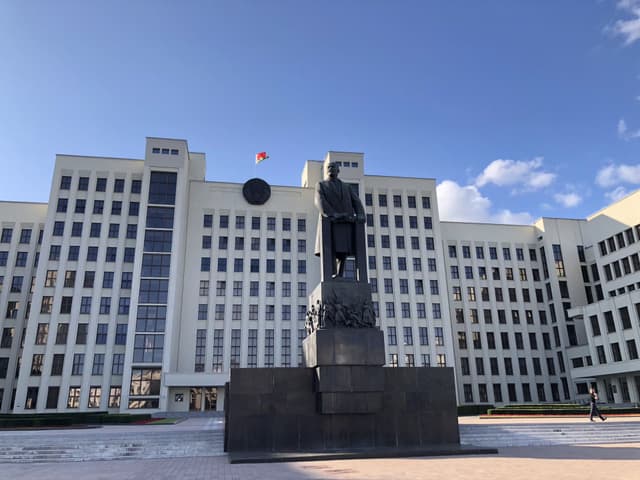Lenin Monument on
Independence Square in Minsk is one of the most famous and largest monuments of the former Soviet Union, which still serves as an important historical and cultural symbol of Belarus. The monument was first erected on November 7, 1933, to mark the 16th anniversary of the October Revolution, and it became the central element of the square, which was then called Lenin Square. The monument's architect was Iosif Grigorievich Langbard, and the sculptor was the renowned Soviet artist Matvey Genrikhovich Manizer.
The monument was conceived as part of the architectural ensemble in front of the House of Government of the Belarusian SSR, whose original design did not include the installation of the monument. However, during construction, Iosif Langbard proposed modifications, replacing the connecting gallery between the building's wings with an open space featuring the Lenin monument. This decision gave the composition a complete appearance and created a powerful symbolic center for the square.
The sculpture is executed in the style of socialist realism, depicting Vladimir Ilyich Lenin during a speech. In his right hand, he holds a cap, symbolizing his closeness to the people, while his left hand rests on a podium railing, as if addressing his audience. This pose conveys confidence and determination, emphasizing Lenin's role as a leader and the head of the proletariat.
The monument was cast in bronze, with its pedestal made of black labradorite. The statue stands 7 meters tall, making it one of the largest in Belarus and across the entire post-Soviet space. Four bas-reliefs are placed on the pedestal, each symbolizing key milestones in the history of the Soviet Union. The first relief is dedicated to the October Revolution, the second to the defense of the Motherland during the Civil War and World War II, the third to the country's industrialization, and the fourth to the collectivization of agriculture. These depictions enhance the monument's symbolic significance, underlining its role not only as a memorial to Lenin but also as a monument to the Soviet era as a whole.
At the time of its unveiling in 1933, the Lenin Monument in Minsk was one of the largest and most significant in the USSR. However, in June 1941, after Minsk was occupied by Nazi troops, the monument was destroyed. The occupiers cut the sculpture into pieces and sent it to Germany to be melted down. This event was a heavy blow to the city's residents, but the memory of the monument and its importance to the city persisted.
After Minsk was liberated from Nazi invaders on July 3, 1944, a decision was made to restore the monument. Fortunately, the original molds of the sculpture were preserved in the workshop of Matvey Manizer in Leningrad, and in April 1945, the monument was recast at the Monument Sculpture Factory. The second ceremonial unveiling of the monument took place on May 1, 1945—symbolically coinciding with the Day of Peace and Labor.
The Lenin Monument on Independence Square has become an integral part of Minsk's urban landscape and is a significant architectural landmark of this central square. It harmoniously complements the majestic House of Government, forming a unified architectural ensemble. The wide steps leading to the pedestal, along with the arrangement of the surrounding space, emphasize its monumental and solemn nature.
In addition to the Lenin Monument, Independence Square is also home to many other important city landmarks. The famous Red Church (Church of Saints Simon and Helena), the building of Belarusian State University, and several government buildings are located here. The modern square is also adorned with green lawns, fountains, and glass domes of the underground shopping center "Stolitsa," making it not only a historic center but also a popular place for walks and leisure.
The Lenin Monument on Independence Square is not only a symbol of the Soviet era but also an important element of Minsk's cultural heritage. It continues to attract interest from both residents and tourists, remaining one of the key points on sightseeing routes in the capital of Belarus. The majestic image of Lenin, immortalized in bronze, still reminds us of significant events in the country's history, of Lenin's role in the formation of the Soviet Union, and of how this shaped the subsequent history of the Belarusian SSR.
The Lenin Monument in Minsk serves not only as a reminder of the past but also as an important element of urban culture, reflecting the complex and multifaceted history of the city. This monument continues to be one of the symbols of Minsk and represents an important part of the cultural heritage not only for Belarus but for all the countries that went through the era of socialism.





.jpg&w=750&q=75)
.jpg&w=750&q=75)

.jpg&w=750&q=75)
.jpg&w=750&q=75)


.jpg&w=750&q=75)











